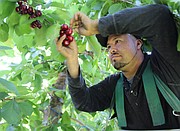Three cheers for cherries; good weather produces profitable crop
CHERYL SCHWEIZER | Hagadone News Network | UPDATED 9 years, 5 months AGO
Senior Reporter Cheryl Schweizer is a journalist with more than 30 years of experience serving small communities in the Pacific Northwest. She began her post-high-school education at Treasure Valley Community College and enerned her journalism degree at Oregon State University. After working for multiple publications, she has settled down at the Columbia Basin Herald and has been a staple of the newsroom for more than a decade. Schweizer’s dedication to her communities and profession has earned her the nickname “The Baroness of Bylines.” She covers a variety of beats including health, business and various municipalities. | July 7, 2016 1:05 PM
QUINCY — Growing cherries – growing any crop, really – isn’t for control freaks. Some of the most critical factors to producing a profitable crop are outside the grower’s control. Cherry harvest weather in 2015 and 2016 is an illustration.
In 2015 it was hot. Really hot, and it stayed hot for a couple of weeks. Triple-digit temperatures meant more fruit ripened at the same time, which meant more fruit on the market at the same time, with a predictable effect on prices. But for the most part Mother Nature has smiled on cherry growers in 2016.
The exception is a rainstorm in mid-June that caused enough damage to reduce the size of the 2016 crop, said Steve Lutz, vice-president of marketing for CMI, Wenatchee. The company markets fruit for a number of warehouses in north central Washington, including Quincy and Ephrata.
Currently red cherry varieties (Bing, Lapin, Skeena and similar varieties) are selling for between $31 and $35 per box, Lutz said, which is 50 cents to $1 higher per box than 2015.
Rainier cherries are selling for about $45 per box, which is slightly below the 2015 price but about a dollar higher than 2014, Lutz said.
Temperate temperatures during the growing season produced larger-than-normal cherries, said Kent Karstetter, co-owner of RJK Fruit, Quincy. “Perfect weather,” he said. More than 50 percent of cherries are premium sizes, compared with about 35 percent in 2015, Lutz said. But what really matters is flavor, he said, and 2016 cherries have plenty of that. “Consumers are happy,” said Karen Lewis, specialist in tree fruit production for WSU-Grant/Adams County Extension.
Warm April weather meant the growing season started early, Lewis said. “We were really early,” the earliest on record, she said.
Despite the conventional wisdom that cherry season peaks about July 4, Lutz said that historically, the peak actually comes during the two to three weeks after July 4. In 2016 the CMI harvest should be completed late this week or early next week. “We are moving through our last big week this week,” he said.
But even with an early start growers avoided the dreaded “cherry glut,” with large numbers of cherries ripening (and coming onto the market) at the same time, and having an effect on prices. “There are going to be good cherries for a longer window of time,” Karstetter said.
Cheryl Schweizer can be reached via email at [email protected].
ARTICLES BY CHERYL SCHWEIZER

Local legislators discuss 2026 session
MOSES LAKE — Washington 13th District legislators previewed what they see as the challenges of the upcoming 2026 session at a meeting with Moses Lake city officials and residents Tuesday. State Senator Judy Warnick, R-Moses Lake, and Representative Tom Dent, R-Moses Lake along with Rep. Alex Ybarra, R-Quincy, outlined some of their plans and ideas as well as the major business of the 2026 legislative session. Warnick said the state faces some challenges.

Dorow appointed to Othello City Council
OTHELLO — Chris Dorow has been appointed to a vacant position on the Othello City Council. Dorow was appointed by unanimous vote after candidates for the seat were interviewed at the Dec. 8 council meeting. There was no discussion. Dorow replaces Denae Valdez, who resigned from the council in November. “We had seven members of the public apply for this position,” said Othello Mayor Shawn Logan.

Grant PUD seeks rate input
EPHRATA — Grant County Public Utility District customers have until Dec. 23 to submit their comments on proposed rate hikes that would go into effect in April 2026. Comments can be submitted at Grant PUD: Commission Meetings. Customers commenting at the last PUD commission meeting of 2025 said higher rates are going to be a challenge. Commissioner Terry Pyle said the PUD is facing challenges too.



